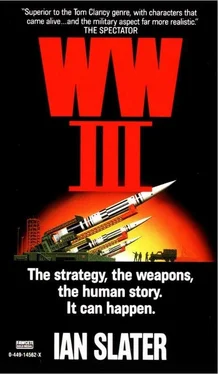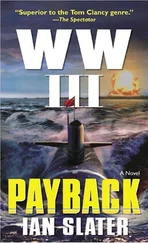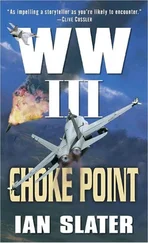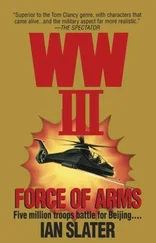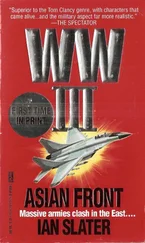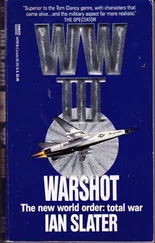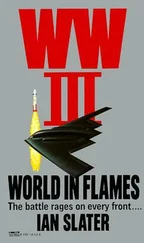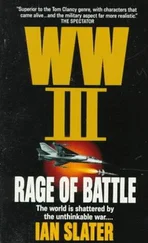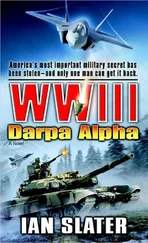Ian Slater - WW III
Здесь есть возможность читать онлайн «Ian Slater - WW III» весь текст электронной книги совершенно бесплатно (целиком полную версию без сокращений). В некоторых случаях можно слушать аудио, скачать через торрент в формате fb2 и присутствует краткое содержание. Год выпуска: 1990, ISBN: 1990, Издательство: Fawcett, Жанр: Триллер, на английском языке. Описание произведения, (предисловие) а так же отзывы посетителей доступны на портале библиотеки ЛибКат.
- Название:WW III
- Автор:
- Издательство:Fawcett
- Жанр:
- Год:1990
- ISBN:978-0449145623
- Рейтинг книги:3 / 5. Голосов: 1
-
Избранное:Добавить в избранное
- Отзывы:
-
Ваша оценка:
- 60
- 1
- 2
- 3
- 4
- 5
WW III: краткое содержание, описание и аннотация
Предлагаем к чтению аннотацию, описание, краткое содержание или предисловие (зависит от того, что написал сам автор книги «WW III»). Если вы не нашли необходимую информацию о книге — напишите в комментариях, мы постараемся отыскать её.
In Europe — Twenty Soviet Warsaw Pact infantry divisions and four thousand tanks begin to move. They are preceded by hundreds of strike aircraft. All are pointed toward the Fulda Gap. And World War III begins…
WW III — читать онлайн бесплатно полную книгу (весь текст) целиком
Ниже представлен текст книги, разбитый по страницам. Система сохранения места последней прочитанной страницы, позволяет с удобством читать онлайн бесплатно книгу «WW III», без необходимости каждый раз заново искать на чём Вы остановились. Поставьте закладку, и сможете в любой момент перейти на страницу, на которой закончили чтение.
Интервал:
Закладка:
The NKA squad leader, in dust-covered green and khaki battle uniform, his face a smudge of camouflage paint, waved for Tae and the lieutenant to come over toward them quickly. The NKA were very professional, no friendliness but not the rage that Tae knew the front line troops often exhibited under fire along the DMZ. The squad leader — up close he reminded Tae a lot of his younger brother in Seoul, an accountant — had Tae manacled, hands behind his back, and scribbled a note on the label that one of the others had looped loosely about his neck. The squad leader detailed two men of the squad to take Tae to Fourth Division HQ immediately. Now four other men, two Americans, two ROK who had only reached the slit trench a hundred yards or so behind Tae’s hut before they came under fire, took their cue from Tae and surrendered. These four, as well as Tae’s lieutenant, were also manacled, and the NKA squad commander bayoneted them, their severed heads stuck on posts around the Quonset hut. It was very important, the squad commander reminded his eight men, that they use the bayonet as much as possible, as a round not fired in action was a round wasted.
He then ordered them to collect all weapons and ammunition in the area that had been abandoned by the “imperialists,” mostly ROK soldiers hastily retreating, ridding themselves of anything that might inhibit them as they ran to catch the last trucks and jeeps out of the area. While most of the machine guns had been spiked and were of no immediate use, they would be collected by mop-up teams and sent back to Pyongyang to be melted down to make new weapons for the Democratic People’s Republic. The M-16 rifles, many of them intact, along with ammunition clips, would be immediately used to arm comrades overrun in the South as they were given the simple choice: join the NKA or be killed.
News of the decapitations at Panmunjom, the squad leader’s superiors knew, would quickly spread through the fleeing ROK regiments and bring the NKA many new recruits. In this the NKA was aided and abetted by General Cahill, who ordered news of the atrocities to be beamed via the three U.S. high-resolution K-band satellites to show the world the kind of people he was up against, believing that it would help galvanize the American public’s support for Korea’s defense. What in hell was Washington doing anyhow?
As far as his shattered local communications allowed him, the general also beamed news of the atrocities to his retreating American regiments. The message here was more brutal: Apart from total victory, the only way out of Korea would be in a body bag.
CHAPTER FOURTEEN
Supported by 2,063 guns, including over two hundred Soviet-made 203-millimeter Corps-level howitzers which the South Koreans did not even know the North possessed, the invasion front now stretched seventeen miles from Kim’s tank and rifle regiments in the west to his four divisions east above Uijongbu.
A Newsweek reporter filed a story about how the big Russian-made 203-millimeter howitzers — part of the price Moscow had paid Kim Il Sung for sending a small but politically highly symbolic contingent of NKA “volunteers” in 1979 to aid the Soviet invasion of Afghanistan — were all mobile, with self-contained tractor-trucks and sixteen-man crews, who were laying down huge variable-bag charges and high-explosive shells at a round a minute, hurling each two-hundred-pound projectile over seventeen miles into Seoul. When the story reached Newsweek’s Tokyo office, en route to the United States, an editor did not consider the part about the circumstances under which the USSR had given the North Koreans the guns to be of “general interest,” and that section was cut as being too dry. In fact, the circumstances under which the guns were given by the USSR to the NKA would have profound implications within the next seventy-six hours, not only for the beleaguered U.S.-ROK forces in South Korea but for the rest of the world.
Meanwhile the world looked on, stunned by the rapidity of the NKA advance and the concomitant humiliation of the Americans. In one brilliant move, primarily through the use of the tunnels, the NKA had not only succeeded in launching an attack beneath and beyond the DMZ in several places, but in doing so, had now trapped over ten thousand “forward troops” of ROK-U.S. command, which had included Major Tae and his intelligence unit. In what was already being called the “squeeze box,” caught between Kim’s troops, who were overrunning the DMZ, and his four crack divisions — over fifty thousand attacking farther south from the tunnels — the zone between the two NKA armies was to be a killing ground unless the surrounded Americans and South Koreans could somehow fight their way out through an escape corridor blasted out by the U.S. Air Force.
It was a dim hope, for at the same time as the Backfires’ attack on Pohang was taking place, all the major air bases throughout the South, including those at Ulsan and Pusan, thirty and sixty miles south of Pohang, were attacked by small, mobile heavy mortar units of activated NKA infiltrators trained in the 124th guerrilla units. At Kwangju in the southwest, an infiltrator group was caught in the process of setting up an eighty-one-millimeter mortar for a concentrated triangle of fire — fifty rounds for the mortar neatly stacked in carefully prepared and camouflaged dumps. This early alarm saved the six F-4 Phantoms normally parked at Kwangju, but the other airstrips came under withering twenty-six-rounds-a-minute heavy mortar fire, effectively destroying the core of the U.S.-ROK’s air interceptor defense, a defense that in the 1950–1953 war had blunted the NKA’s dash southward to Pusan.
The ‘50-’53 war, however, and Vietnam, particularly the North Vietnamese Communists’ siege of Khe Sahn, had taught the NKA and the 350,00 °Chinese volunteers in that war that while enemy air power alone could not win a conventional war, its ability to play havoc with your supply lines and to resupply its own troops, giving them valuable breathing space even to the point of enabling them to mount a counterattack, could be formidable. For General Kim the only answer to this was the present byorak kongkyok— “lightning war”—in which the primary objectives, the enemy’s air bases, had been taken out by the NKA’s own air strikes or, as in most cases, had been rendered inoperative so swiftly from within that the United States, even with its massive reserves in Japan and its B-52 bases in Okinawa, would be unable to catch its breath before Korea was lost.
CHAPTER FIFTEEN
At dawn, heading south down Korea’s rugged east coast, a supertanker, the MV New Orleans, had requested ROK coast guard assistance. Several miles north of Pohang she reported that whatever it was that had struck her, a ship-to-ship or air-to-ship missile, she was badly holed in her stern, had lost control of her rudder, including the auxiliary, and was now drifting. While one of the three ROK destroyers in Pohang Harbor was ordered by ROK’s Area Five’s southern command to remain behind on picket duty, just beyond Cape Changgi, the other two destroyers were sent to assist the tanker out of fear that a massive spill oif South Korea’s famed beaches would feed the inferno on Pohang’s waterfront, or rather what was left of it after the Backfires’ sneak attack.
The tanker was now a mile from the two ROK destroyers, themselves a quarter mile apart, their captains deciding the best way to harness a towline before trying to deal with the problem of the hole in her stern, not yet visible because of the head-on angle of the tanker. As dangerous as the salvage procedure would be in the deteriorating weather, both skippers were greatly relieved at having the opportunity to haul the leviathan away from the coast. It would recoup part of the acute loss of face, which they were suffering after having failed earlier to detect the approach of the low-flying Backfires, though they guessed, correctly, that at that moment there were many others throughout the length and breadth of South Korea who could see court-martials stretching before them. Indeed the NKA infiltration units had been so successful that the problem facing U.S.-ROK HQ was that if everyone were to be court-martialed who should be, particularly those who had parked their fighters in rows instead of “staggering” them, the armed forces attorneys general would have enough work for the next ten years. However, morale was so low that Seoul HQ decided that to call so many to account at once would only further erode the army’s confidence and add to the already acute embarrassment of Seoul and Washington.
Читать дальшеИнтервал:
Закладка:
Похожие книги на «WW III»
Представляем Вашему вниманию похожие книги на «WW III» списком для выбора. Мы отобрали схожую по названию и смыслу литературу в надежде предоставить читателям больше вариантов отыскать новые, интересные, ещё непрочитанные произведения.
Обсуждение, отзывы о книге «WW III» и просто собственные мнения читателей. Оставьте ваши комментарии, напишите, что Вы думаете о произведении, его смысле или главных героях. Укажите что конкретно понравилось, а что нет, и почему Вы так считаете.
